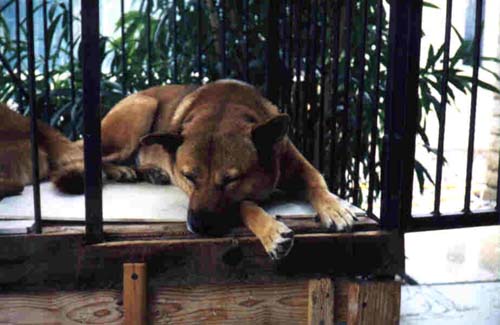Containment
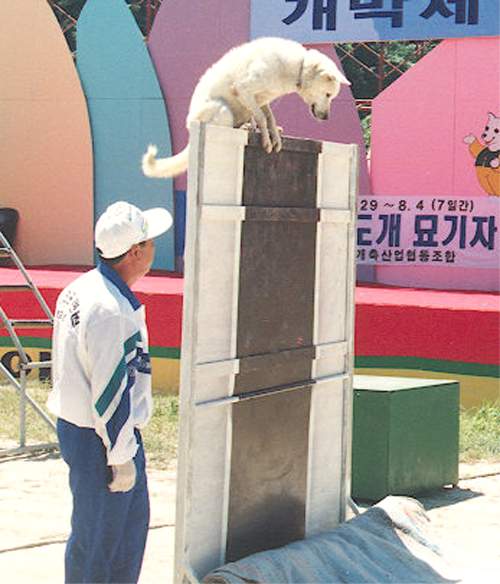
"ByukPa"
practice jump for the
1997 Jindo Island show |
A Jindo is by nature an independent and territorial dog. Given the opportunity, a Jindo would love to explore his/her surrounding
area and include it into its own territory. However, allowing Jindos to run free around the neighborhood can lead to problems for you,
your neighbors, and your Jindo.
If your free-roaming Jindo does not get hit by a car, it can develop some undesirable habits as it wanders around. Whenever a dog
is allowed to wander freely in his/her neighborhood, the dog then in its mind believes the entire area it roamed in is his/hers. So if the
dog roams 4 blocks in one way and 3 blocks in another - that's the territory the dog considers as his/hers. Strangers, kids,
neighbors, and other dogs are considered intruders and occur the full wrath of a territorial Jindo. This can in term lead to the
stranger being badly hurt, the dog being destroyed, and the owner being held liable for damages. The reputation of the entire breed
is soiled and home insurance rates skyrocket to cover the possibility of the owners being sued. The Akita and Chow are just two
breeds on several dangerous dog lists or breed bans. It only takes the actions of a few irresponsible Jindo owners to add the Jindo
to those lists.
This being said, the best way to avoid these situations is to know how to properly confine your Jindo. There are several options
when it comes to this. Here are some of them:
1. Kennel runs.
The easiest available kennels are made out of chain-link fencing. Success varies on how well this works and depends highly on
the dog and the construction of the kennel. Some dogs are actually capable of stretching the links far enough to escape their
kennels. Other dogs climb the links and escape over the top of the kennel. Still others are content to leave the boundaries alone.
Pictured below is a type of kennel that have worked for Jindos in Korea.
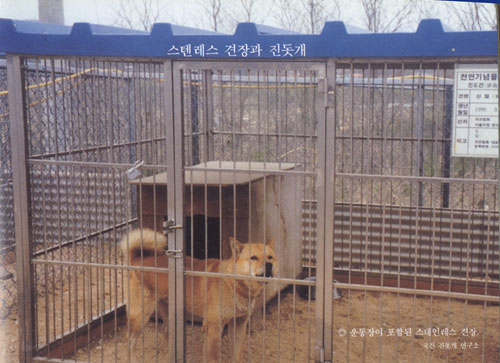
photo by Woo, Mu Jong |
Note that the cage has a top to provide shade as well as to prevent jumps. There are minimal horizonal bars to prevent climbing. The bars are of a thick enough grade to prevent bending and distortion by the dog. In the above picture, digging escapes are prevented by setting the fence panels on a solid base that is set below the level of the ground. Alternative kennels have a solid kennel floor made out of concrete or some other dig-resistant material.
A dog
house is supplied to give a soft den and protection from the elements. A water bowl is left in the cage.
There is enough space for the dog to move around and if urgent,
relieve himself although most Jindos will resist going in the kennel.
I'm of the opinion that this method of confinement is best if you have a known escaper and need to keep your dog outside for long, unsupervised periods of time.
2. Outdoor cage
A variation of the kennel run is an outdoor cage made out of the heavy gauge rods.
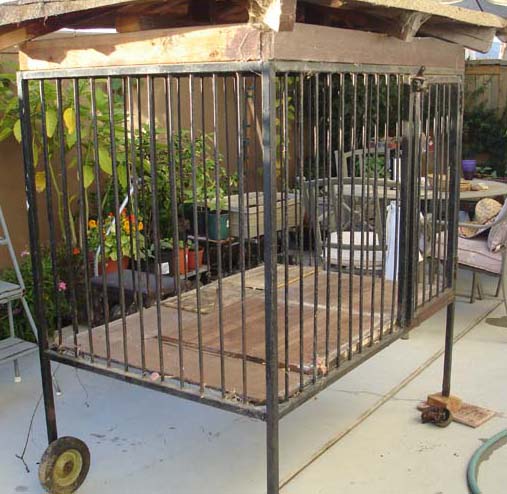
neglected but still functional cage |
The above cage was custom-welded by a Jindo owner in Los Angeles and used for many years. The dimensions are roughly 3 ft wide, 4 ft long, and 3 ft high which gives the dog plenty of room to stand, lay down, and turn around. The height of the cage floor is elevated to roughly 18 inches, which is claimed to be higher than the height a flea can jump up. The roof, the wheels, and the wooden scrap floor were add-ons and can be removed or upgraded. A water bowl would normally be in the cage when the cage was in use.
This cage is advantageous when keep under a house roof such as under a covered patio. Though it does not protect from rain or the elements by itself, it allows plenty of air circulation which is needed in warmer areas such as southern California. The cage is intended to be used as confinement for only a few hours at maximum, such as when feeding a dog away from other dogs, when drying a dog after a bath, when a backyard gate would be repeatedly opened and closed, or when guests are not ready to meet a loose dog.
With enough treats and meals given within the cage, dogs will learn to enjoy the view from inside and will often jump in by themselves when the cage door is left open.
3. Indoor Crate or Cage.
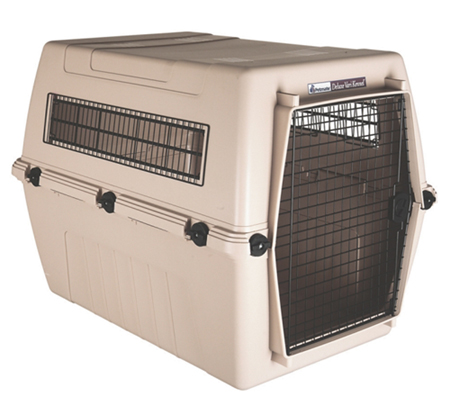
a crate of the Varikennel line |
This method is advocated by American dog owners. The principal behind the crate is that in the wild, dogs and wolves need a
den or hide-a-way for their home. Except for hunting, eliminating, playtime and protection, they spend hours sleeping, eating or
relaxing in their den. The crate/cage just becomes their substitute den and can keep the dog confined inside the house without any danger of escaping or chewing something inappropriate. After the dog becomes trustworthy in the house, the dog can be
kept loose within the house as a means of confinement.
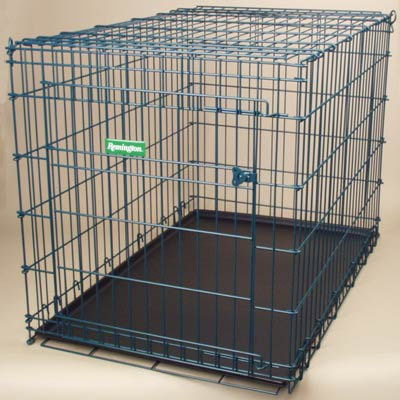
a wire kennel or cage |
Like the outdoor cage, the indoor crate or cage is intended to be used for only a couple of hours and the dog would need to be pre-conditioned towards the crate or cage. Some dogs with separation anxiety are unsuited for crate confinement as it worsens their condition and they break their teeth trying to get out.
There are some dogs that can escape from these crates and cages. Dogs have been known to chew their way out of a crate.
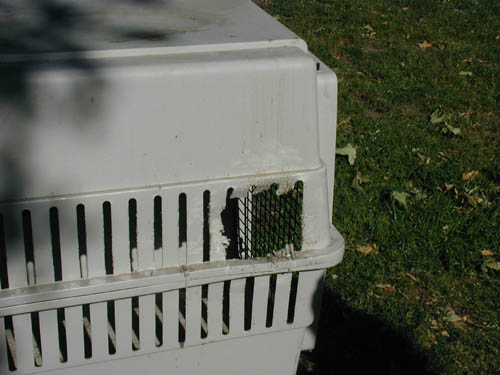
This hole provides an escape point for a Jindo |
Some powerful dogs have also pushed the door out, particularly when the bolts connecting the top and bottom shells of the crate have loosen.
4. Indoor Exercise Pen (x-pen)
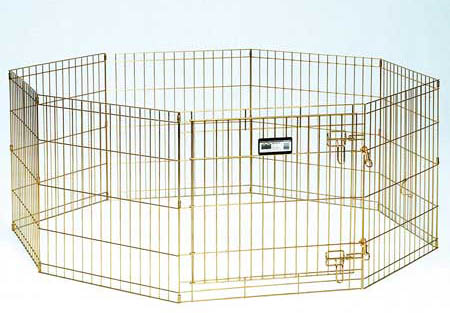
Exercise pen, nicknamed x-pen. |
Although marketed for outdoor use for dogs, the exercise pen is insufficient to hold in a Jindo. When motivated, they can jump clear of the pen if no top is attached. Even when a top is attached, the give and take of the pen walls encourages escapers to move the pen, dig at the bottom of the pen, and so on. Thus a Jindo must be constantly supervised when in an exercise pen outdoors and when there exist no backup barrier to prevent complete escapes.
In an indoor setting, the exercise pen offers more freedom than a crate or cage and allows the dog to be left home alone for a longer period of time. Because the pen is indoors, there should be less visual temptations for the Jindo to want to escape.
4. Tether, Chain
Originally, I was against the use of chains and tethers in a suburban setting, but after reading research on the matter and how
animal rights extremists have distorted the issue, I am modifying that position. Here is an article written by Cornell University
College of Veterinary Medicine on the matter:
Study Abstract from the Journal of Applied Animal Welfare Science:
2001, Vol. 4, No. 4, Pages 257-270
This study compared general activity and specific behaviors of 30
adult Alaskan sled dogs, 19 male and 11 female dogs, on 3.5 m tethers
and in 5.9 m2 pens. The investigators used activity level and
steriotypies as indicators of welfare. The dogs spent most of their
time inactive, either lying or sitting both on the tether and in the
pen. They had more opportunity for interaction with one another but
less space in the pen (5.9 m2 in the pen vs. 38.5 m2 on the tether).
Standing on the hind legs (p < .05) occurred more frequently in the
pens; circling was more frequent on the tethers (p < .05). The U.S.
Department of Agriculture approves penning but not tethering of dogs; however, the behavior of the dogs in this study did not indicate an
improvement in welfare in pens.
Like ALL methods of containments, there will be ignorant or malicious people who use tethering inappropriately so that the dog is
under abuse. However, I've also know of Jindos who spent time on tethers that still received plenty of human interaction and care
and are not aggressive or frustrated dogs. It depends on the owner and the context.
The collar needs to be appropriate. A limited slip collar seems to offer the best compromise between safety and
yet stopping escapes.
The tether length should be long enough so that the dog could relieve itself but also short enough so that the dog
couldn't hang itself by jumping a fence.
The area needs to be clear of debri that would entangle and shorten the tether.
The point of attachment to both the stationary object and the dog's collar needs to swivel freely.
Shelter / shade needs to be available throughout the day. A dog that is covered by shade in the morning could lose
its shade by noontime. A dog that is out on a clear morning could end up soaked if it rains while the owner is
away. For people in winter climates, a dog needs good insulaton from the weather. (Yes, even a double-coated
breed like a Jindo needs protection from the elements.) Dog house openings should be orientated so wind can not
blow directly inside it. Straw sold in livestock stores can offer a inexpensive way to add insulation inside a dog
house, however, the straw should be checked regularly and replaced so the dog remains clean and dry.
Fresh water should be available at all times in a container that cannot tip over. For people in winter climates,
owners need to make sure that the water is not frozen solid.
The dog should be fed at regular intervals. I don't recommend leaving out huge amounts of food as it attracts ants
and makes the food unconsumable.
The dog should be acclimated to the tether under supervision.
The dog should never be in a situation where he/she is teased by people.
The dog should be given times to stretch his/her legs and exercise off the tether. The exercise should not just be a
jaunt around the yard, but a time to stimulate the mind, tire the body, and reinforce the bond between dog and
owner.
The dog should NEVER be ignored by the owner or family. A dog is a living animal with needs and feelings.
Tethering is a tool to help people live WITH dogs. If the owner or family has no desire to interact with the dog and
live WITH the dog, then they should not be owning a dog in the first place.
5. Trolley
The trolley offers an upgrade from the chain and tether set-up. Many of the same concerns still need to be addressed such as suitable collar, clearing of obstructions, shelter, water, and protection from teasing. However, the trolley offers much greater range in movement.
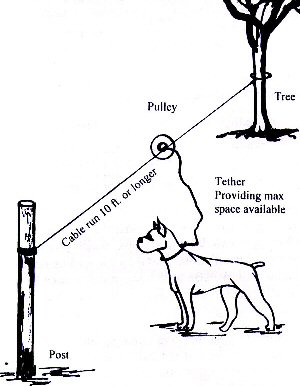
Trolley diagram |
Fences
1. Block Fence.
If a person has the choice and the means, I believe a block fence that is buried a foot deep and is 7 ft above ground is the best fence for a backyard. However, this is very cost-prohibitive. The block fence should be a permanent fixture and so it is very important to first check property lines and clear it with any local HOA and neighbors.
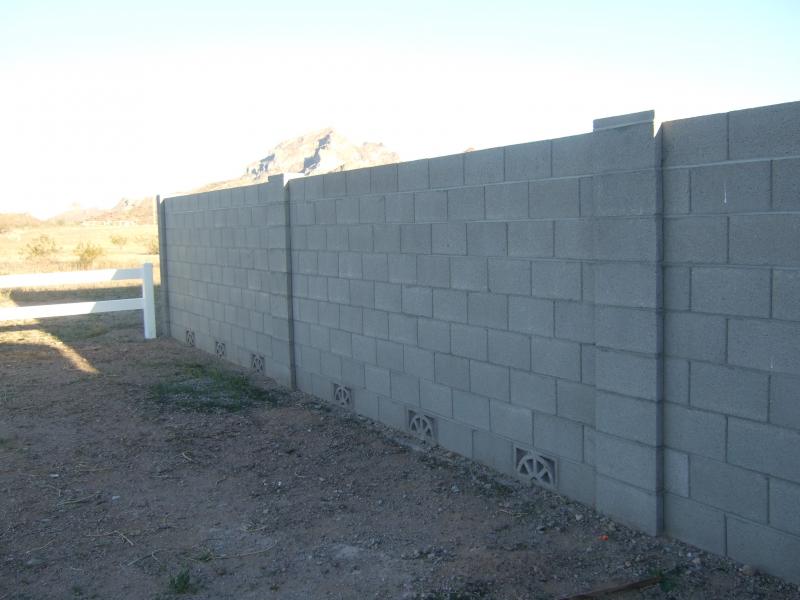
cinder block fence with drainage at the bottom |
2. Vinyl fence.
A vinyl fence has the advantage of being clean and astetically pleasing. If ever a wall needs to be moved, it is an easier task to do than with a block fence. The weakness would be the gap at the bottom of the fence and the price.
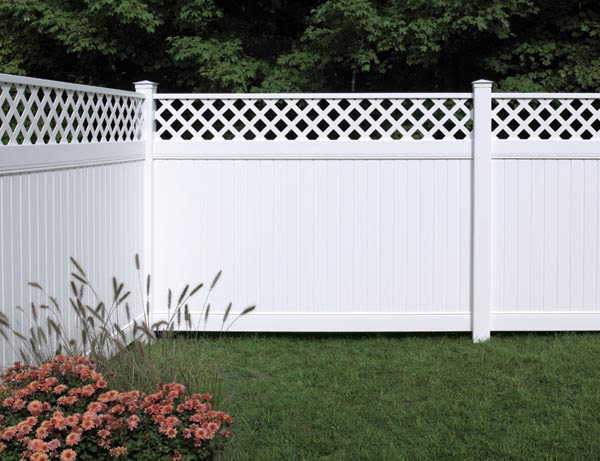
vinyl fence with decorative top |
3. Wrought Iron Fence (Steel sometimes available).
A wrought iron fence is very sturdy and most Jindos are not able to gain enough purchase with their legs on the rods to scale/jump over these fences. The iron fence do need to be maintained so they do not rust. Steel may be available in some areas to avoid this problem.
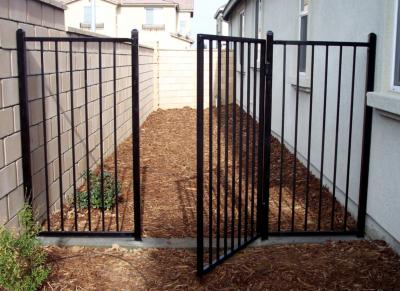
wrought iron fence |
Some variations have the lower portion of the fence made out of block and the upper portion made out of the iron fence.
Care have to be taken that the view through the fence does not unduely agitate the dog. The spacing between the rods should be conservative. It is better to err on the small side rather than be too wide.
4. Wooden Fence.
A wooden fence is common and can be installed by a do-it-yourself homeowner at relatively low costs. The disadvantage would be the possibility of the dog biting and chewing through the fence to escape, or the fence being weakened by weather and termites. Wooden fences may have a gap at the base.
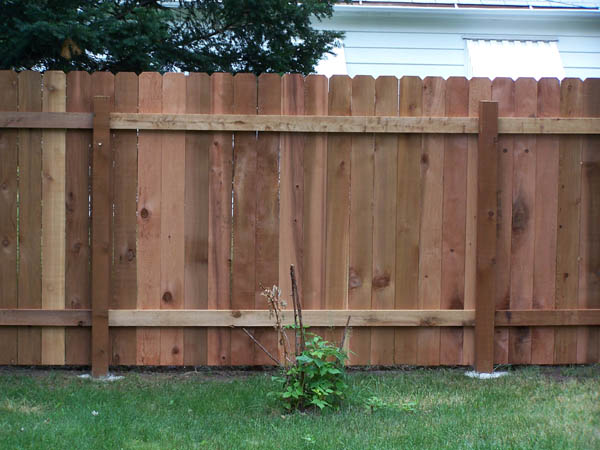
wooden fence |
5. Chain-link or cyclone fence.
A chain-link or cyclone fence is easy to install and the base can be buried to prevent digging, but they are considered unastetically pleasing. Also, they have the disadvantage that the dog can see through them and be tempted or annoyed by passerbyers. Dogs can also climb the fence or distort the links so they can escape.
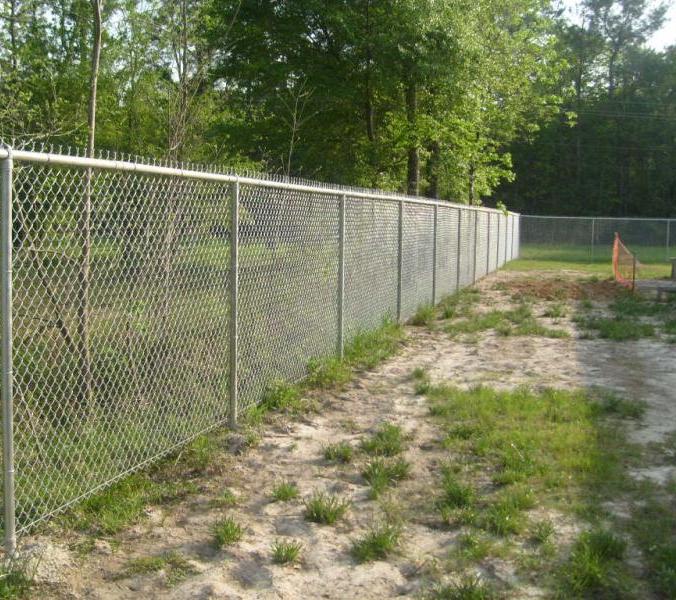
chain link fence |
6. Invisible or remote fencing.
This fence is strongly not recommended for a Jindo.
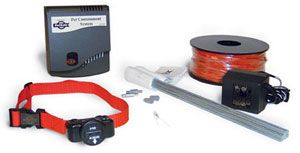
invisible fence |
Reinforcing existing fences
One of the most frustrating problem that first-time Jindo owners may encounter is a Jindo escaping from a seemingly secure fenced backyard. In addition to the fear that the dog may be killed by a car, there is the added stress of dealing with angry, complaining neighbors and reclaiming the dog from a hostile animal control.
It may not be possible to change a fence, so here are some low-cost ways to prevent a Jindo from escaping from an existing fenced yard.
1. "Hot wire" or electrified fence.
A hot wire can be placed to teach a dog to respect an existing fence border. It can stop jumpers and diggers from escaping, or if there are livestock on the property, prevent the dog from attacking the livestock. This has a high success rate and is an old but well-known tactic. They are available in livestock stores and some home improvement stores for about $50.
The disadvantage would be some areas and HOAs prohibit the use of hot wires.
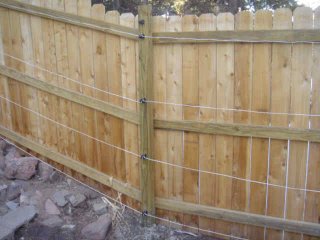
hot wire added to a wooden fence |
2. Jumping barriers.
For jumpers, there are some modifications that can be added to an existing fence to prevent escapes.
Add a 45-degree inward extension to the top of an existing fence. Home improvement stores can help in setting this up.
Increase the height of the fence by adding mesh fencing or hardware cloth. These are available in home improvement stores.
Attach inexpensive bamboo or reed fencing to the existing fence. These come in 6 ft rolls and can be staggered for more height. This would not only be a visual deterrent to the dog, it would also be more difficult for the dog to gain purchase on this slick surface.
Attach a trellis to the fence, or add a trellis in front of the fence. If the wooden version found in home improvement store's garden area is too cost prohibitive to cover a large area, a visit to the rebar/concrete section of the store might provide a thick-gauge iron grid that could be spray-painted and then posted in front of an existing fence.
3. Digging barriers.
To stop diggers, bury chicken wire to a depth of one foot below where the fence meets the ground (be sure to bend-in the sharp edges). For stronger dogs, use livestock panels, bent into an L shape and buried underground.
For some diggers, concrete blocks around the bottom of the fence are enough to deter the dog. Jindos are powerful enough to move cinder blocks though. Large flat stepping stones are also an option. The stone would have to be big enough that the dog could not get to the base of the fence without stepping on the stone.
A more labor intensive tactic is to dig a trough under the fence and fill it with concrete (along the full length of the fence or only in "trouble spots"). A less labor intensive tactic is to place bags of concrete mix alongside the base of the fence. Wet the bags. As the paper disintergrates with time, they form fake boulders alongside the fence.
4. Stopping fence rippers.
Other than installing hot wires, there is no other choice but to purchase panels to protect the fence from a dog that rips into a fence.
Aluminum panels should be screwed into a wood fence. The ends should be checked regularly for edges that may snag or cut the dog.
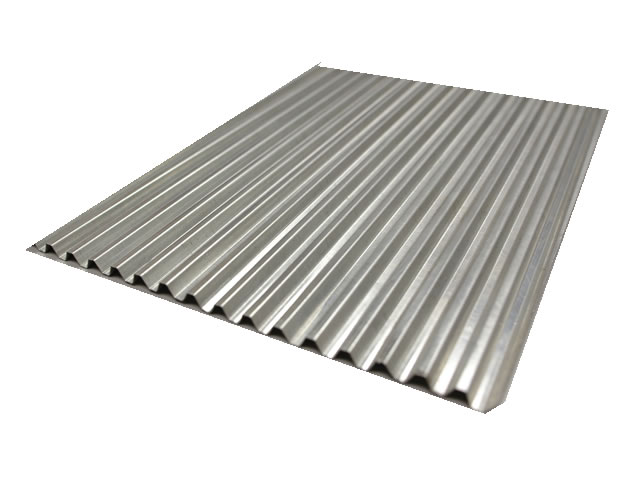
aluminum corrugated sheets |
Livestock panels should have closely spaced grids. Livestock panels meant for hogs, with closer spacing at the bottom, are also effective for containing diggers.

livestock panel |

hog panel
|





